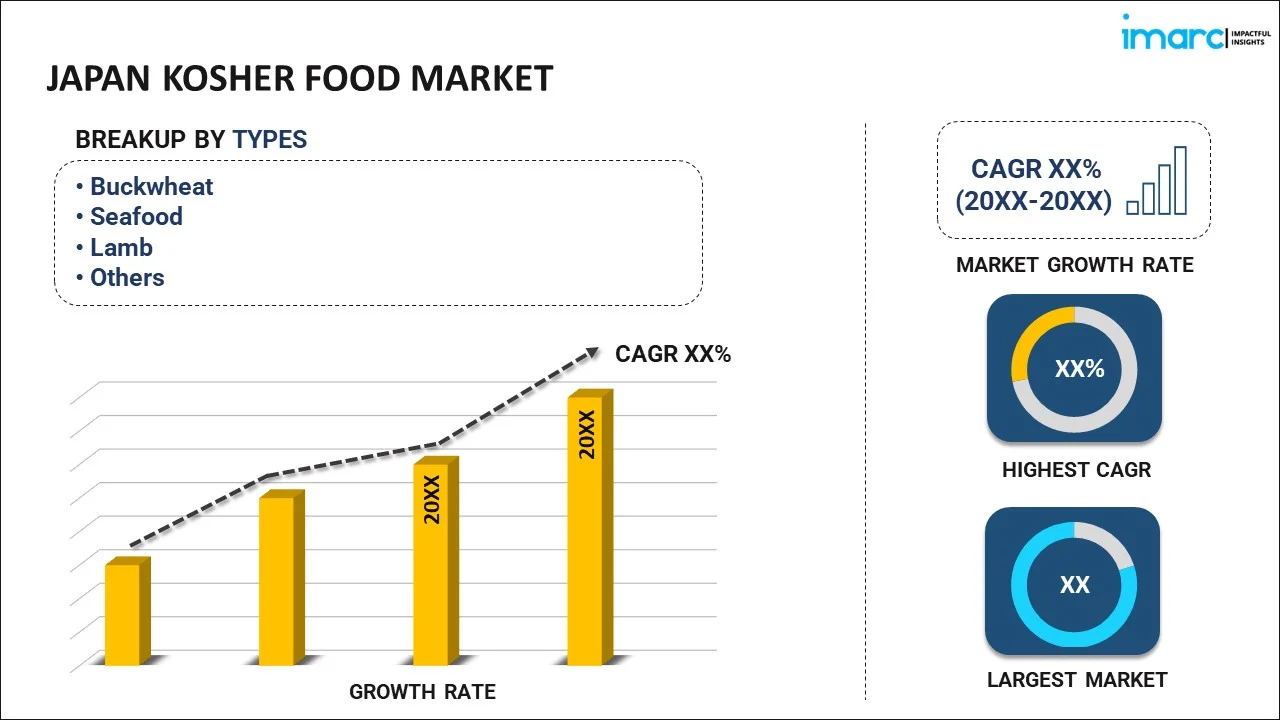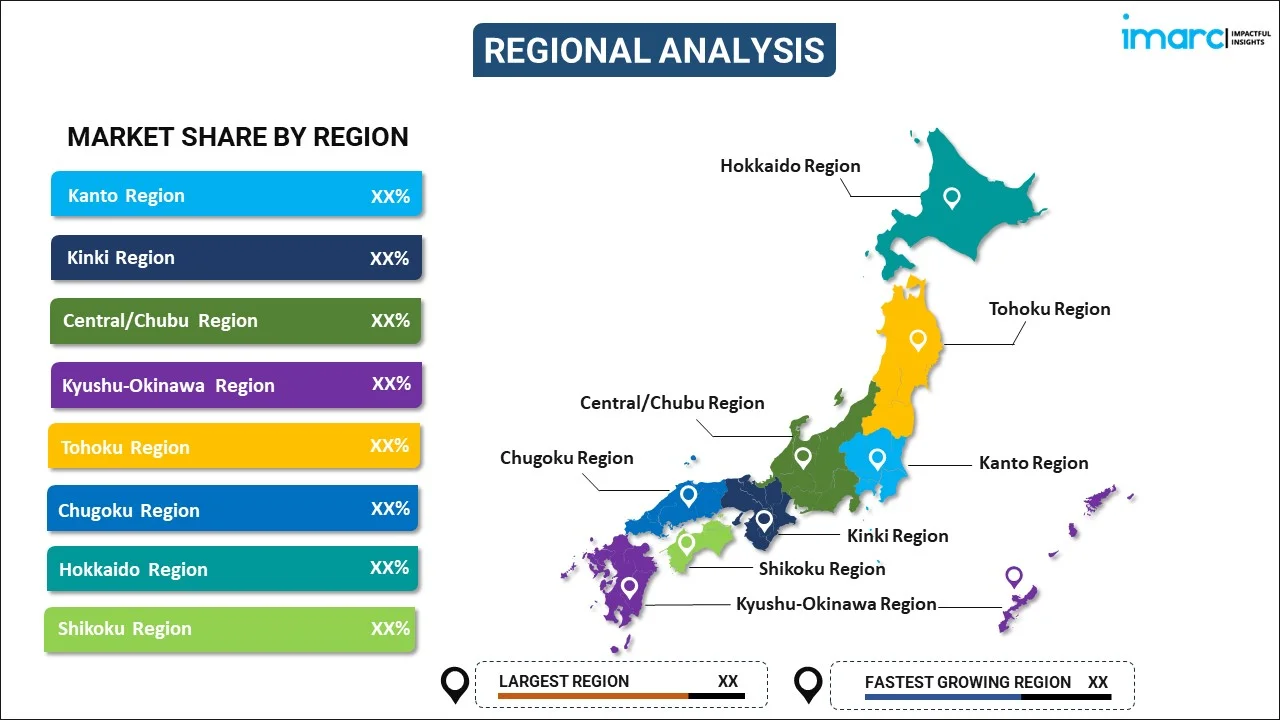
Japan Kosher Food Market Report by Type (Buckwheat, Seafood, Lamb, Pulses, and Others), Application (Culinary Products, Snacks and Savory, Bakery and Confectionery Products, Meat, Beverages, Dietary Supplements), Distribution Channel (Supermarkets and Hypermarkets, Grocery Stores, Online Stores), and Region 2025-2033
Market Overview:
The Japan kosher food market size reached USD 1,307 Million in 2024. Looking forward, IMARC Group expects the market to reach USD 1,804 Million by 2033, exhibiting a growth rate (CAGR) of 3.6% during 2025-2033. The increasing awareness of dietary preferences and health-consciousness among consumers, growing interest in ethically sourced and environmentally responsible products and the development of hotels, restaurants, and food establishments represent some of the key factors driving the market.
|
Report Attribute
|
Key Statistics
|
|---|---|
|
Base Year
|
2024 |
|
Forecast Years
|
2025-2033
|
|
Historical Years
|
2019-2024
|
| Market Size in 2024 | USD 1,307 Million |
| Market Forecast in 2033 | USD 1,804 Million |
| Market Growth Rate (2025-2033) | 3.6% |
Kosher food stands at the intersection of tradition, culture, and dietary observance, reflecting a meticulous set of guidelines that govern the preparation, consumption, and handling of food products. Just as industrial degreasers are formulated for specific cleaning needs, kosher food adheres to stringent regulations that dictate the types of ingredients used, the method of preparation, and even the utensils employed. These guidelines, rooted in religious practices, ensure that food is prepared in accordance with Jewish dietary laws. From the sourcing of ingredients to the cooking process, kosher food carries significance not only for its adherence to religious principles but also for its assurance of quality and integrity. Kosher food emerges as a culinary category with deep-rooted historical and religious significance. Spanning far beyond the realm of taste, kosher food embodies traditions passed down through generations, reflecting a profound connection to cultural heritage and spiritual practice. These culinary guidelines, intricately interwoven with Jewish beliefs, elevate kosher food beyond mere sustenance, highlighting its role as a symbolic expression of identity and reverence.
Japan Kosher Food Market Trends:
The Japan kosher food market has witnessed significant growth and innovation fueled by the increasing awareness of dietary preferences and health-consciousness among consumers. Just as industrial degreasers cater to specific cleaning needs, kosher food addresses a niche market seeking meticulously crafted options aligned with religious and dietary requirements. In Japan, a country known for its culinary diversity, the demand for kosher food is expanding beyond the Jewish community, attracting health-conscious consumers who value the stringent regulations governing its production. Moreover, technology and globalization are impacting the kosher food market, echoing the integration of innovation in various industries. As supply chains become more interconnected, access to kosher-certified ingredients from around the world becomes easier, aligning with trends in international trade. Additionally, sustainability concerns, including the adoption of eco-friendly degreasers, influence the kosher food market. Consumers' growing interest in ethically sourced and environmentally responsible products extends to their dietary choices, fostering demand for kosher food that aligns with these values. Apart from this, the influence of globalization is evident in the rising popularity of kosher food. As industries benefit from global connectivity, international travel and exposure to diverse cuisines have piqued the interest of Japanese consumers in exploring kosher dining options. Also, the hospitality and tourism sectors play a role in propelling the kosher food market. Hotels, restaurants, and food establishments that offer kosher options attract a broader clientele, including international travelers and visitors seeking familiar dining experiences, thereby acting as a growth-inducing factor.
Japan Kosher Food Market Segmentation:
IMARC Group provides an analysis of the key trends in each segment of the Japan kosher food market report, along with forecasts at the country level for 2025-2033. Our report has categorized the market based on type, application and distribution channel.
Type Insights:

- Buckwheat
- Seafood
- Lamb
- Pulses
- Others
The report has provided a detailed breakup and analysis of the market based on the type. This includes buckwheat, seafood, lamb, pulses and others.
Application Insights:
- Culinary Products
- Snacks and Savory
- Bakery and Confectionery Products
- Meat
- Beverages
- Dietary Supplements
A detailed breakup and analysis of the Japan kosher food market based on the application has also been provided in the report. This includes culinary products, snacks and savory, bakery and confectionery products, meat, beverages and dietary supplements.
Distribution Channel Insights:
- Supermarkets and Hypermarkets
- Grocery Stores
- Online Stores
The report has provided a detailed breakup and analysis of the market based on the distribution channel. This includes supermarkets and hypermarkets, grocery stores and online stores.
Regional Insights:

- Kanto Region
- Kinki Region
- Central/ Chubu Region
- Kyushu-Okinawa Region
- Tohoku Region
- Chugoku Region
- Hokkaido Region
- Shikoku Region
The report has also provided a comprehensive analysis of all the major regional markets, which include Kanto Region, Kinki Region, Central/ Chubu Region, Kyushu-Okinawa Region, Tohoku Region, Chugoku Region, Hokkaido Region and Shikoku Region.
Competitive Landscape:
The report has also provided a comprehensive analysis of the competitive landscape in the market. Competitive analysis such as market structure, key player positioning, top winning strategies, competitive dashboard, and company evaluation quadrant has been covered in the report. Also, detailed profiles of all major companies have been provided.
Japan Kosher Food Report Coverage:
| Report Features | Details |
|---|---|
| Base Year of the Analysis | 2024 |
| Historical Period | 2019-2024 |
| Forecast Period | 2025-2033 |
| Units | Million USD |
| Scope of the Report | Exploration of Historical and Forecast Trends, Industry Catalysts and Challenges, Segment-Wise Historical and Predictive Market Assessment:
|
| Types Covered | Buckwheat, Seafood, Lamb, Pulses, Others |
| Applications Covered | Culinary Products, Snacks and Savory, Bakery and Confectionery Products, Meat, Beverages, Dietary Supplements |
| Distribution Channels Covered | Supermarkets and Hypermarkets, Grocery Stores, Online Stores |
| Regions Covered | Kanto Region, Kinki Region, Central/ Chubu Region, Kyushu-Okinawa Region, Tohoku Region, Chugoku Region, Hokkaido Region, Shikoku Region |
| Customization Scope | 10% Free Customization |
| Post-Sale Analyst Support | 10-12 Weeks |
| Delivery Format | PDF and Excel through Email (We can also provide the editable version of the report in PPT/Word format on special request) |
Key Questions Answered in This Report:
- How has the Japan kosher food market performed so far and how will it perform in the coming years?
- What has been the impact of COVID-19 on the Japan kosher food market?
- What is the breakup of the Japan kosher food market on the basis of type?
- What is the breakup of the Japan kosher food market on the basis of application?
- What is the breakup of the Japan kosher food market on the basis of distribution channel?
- What are the various stages in the value chain of the Japan kosher food market?
- What are the key driving factors and challenges in the Japan kosher food market?
- What is the structure of the Japan kosher food market and who are the key players?
- What is the degree of competition in the Japan kosher food market?
Key Benefits for Stakeholders:
- IMARC’s report offers a comprehensive quantitative analysis of various market segments, historical and current market trends, market forecasts, and dynamics of the Japan kosher food market from 2019-2033.
- The research study provides the latest information on the market drivers, challenges, and opportunities in the Japan kosher food market.
- Porter's five forces analysis assist stakeholders in assessing the impact of new entrants, competitive rivalry, supplier power, buyer power, and the threat of substitution. It helps stakeholders to analyze the level of competition within the Japan kosher food industry and its attractiveness.
- Competitive landscape allows stakeholders to understand their competitive environment and provides an insight into the current positions of key players in the market.
Need more help?
- Speak to our experienced analysts for insights on the current market scenarios.
- Include additional segments and countries to customize the report as per your requirement.
- Gain an unparalleled competitive advantage in your domain by understanding how to utilize the report and positively impacting your operations and revenue.
- For further assistance, please connect with our analysts.
 Inquire Before Buying
Inquire Before Buying
 Speak to an Analyst
Speak to an Analyst
 Request Brochure
Request Brochure
 Request Customization
Request Customization




.webp)




.webp)












